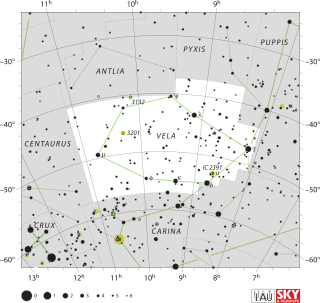This page is based on this
Wikipedia article Text is available under the
CC BY-SA 4.0 license; additional terms may apply.
Images, videos and audio are available under their respective licenses.

Vela is a constellation in the southern sky. Its name is Latin for the sails of a ship, and it was originally part of a larger constellation, the ship Argo Navis, which was later divided into three parts, the others being Carina and Puppis. With an apparent magnitude of 1.8, its brightest star is the hot blue multiple star Gamma Velorum, one component of which is the brightest Wolf-Rayet star in the sky. Delta and Kappa Velorum, together with Epsilon and Iota Carinae, form the asterism known as the False Cross. 1.95-magnitude Delta is actually a triple or quintuple star system.

Eta Canis Majoris, also named Aludra, is a star in the constellation of Canis Major. Since 1943, the spectrum of this star has served as one of the stable anchor points by which other stars are classified.

Delta Velorum is a triple star system in the southern constellation of Vela, near the border with Carina, and is part of the False Cross. Based on parallax measurements, it is approximately 80.6 light-years from the Sun. It is one of the stars that at times lies near the south celestial pole due to precession.

Phi Velorum is a star in the constellation Vela. It is a blue-white B-type supergiant with an apparent magnitude of +3.53. It is approximately 1,590 light years from Earth.

Omicron Velorum is a star in the constellation Vela. It is the brightest member of the loose naked eye open cluster IC 2391, also known as the ο Velorum Cluster.
The Bayer designations n Velorum and N Velorum are distinct. Due to technical limitations, both designations link here. For the star
The Bayer designations c Velorum and C Velorum are distinct. Due to technical limitations, both designations link here. For the star
The Bayer designations a Velorum and A Velorum are distinct. Due to technical limitations, both designations link here. For the star

IC 2391 is an open cluster in the constellation Vela. The Persian astronomer Al Sufi may have first described it about 964. It was found by Abbe Lacaille and cataloged as Lac II 5.

Omicron Puppis (ο Puppis) is candidate binary star system in the southern constellation of Puppis. It is visible to the naked eye, having a combined apparent visual magnitude of +4.48. Based upon an annual parallax shift of 2.30 mas as seen from Earth, it is located roughly 1,400 light years from the Sun.
The Bayer designations b Velorum and B Velorum are distinct. Due to technical limitations, both designations link here. For the star
The Bayer designations q Velorum and Q Velorum are distinct. Due to technical limitations, both designations link here. For the star
The Bayer designations d Velorum and D Velorum are distinct.
Due to technical limitations, both designations link here.
The Bayer designations e Velorum and E Velorum are distinct. Due to technical limitations, both designations link here. For the star
The Bayer designations f Velorum and F Velorum are distinct. Due to technical limitations, both designations link here. For the star
The Bayer designations i Velorum and I Velorum are distinct. Due to technical limitations, both designations link here. For the star
The Bayer designations k Velorum and K Velorum are distinct. Due to technical limitations, both designations link here. For the star
The Bayer designations l Velorum and L Velorum are distinct. Due to technical limitations, both designations link here. For the star
The Bayer designations m Velorum and M Velorum are distinct. Due to technical limitations, both designations link here. For the star




